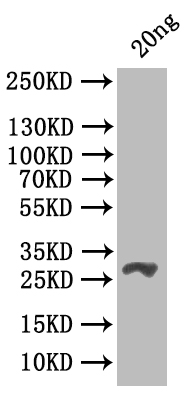To generate the csgD polyclonal antibody, a recombinant Escherichia coli (strain K12) csgD protein (amino acids 1-216) is used as the immunogen, which is then administered to a rabbit to elicit an antibody response. The serum obtained from the rabbit contains polyclonal antibodies, which are subsequently purified using affinity chromatography. The proficiency of the csgD antibody in detecting the Escherichia coli (strain K12) csgD protein is assessed through ELISA and WB assays, confirming its suitability for experimental use.
The csgD protein in Escherichia coli (strain K12) is a transcriptional regulator crucial for orchestrating the synthesis and assembly of curli fibers, and extracellular amyloid structures with diverse functions. CsgD promotes the expression of genes involved in curli biosynthesis, export, and assembly. Additionally, CsgD-mediated adhesion to surfaces is pivotal for initial biofilm development and colonization of diverse environments, including host tissues.







